

IT Architecture, Infrastructure & Integrations. Strings of tailored ABAP code are used to customize the implementation of processes; if this in turn provides a competitive advantage, so does your code itself.
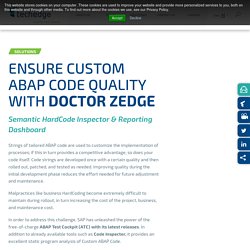
Code strings are developed once with a certain quality and then rolled out, patched, and tested as needed. Improving quality during the initial development phase reduces the effort needed for future adjustment and maintenance. Malpractices like business HardCoding become extremely difficult to maintain during rollout, in turn increasing the cost of the project, business, and maintenance cost.
In order to address this challenge, SAP has unleashed the power of the free-of-charge ABAP Test Cockpit (ATC) with its latest releases. In addition to already available tools such as Code Inspector, it provides an excellent static program analysis of Custom ABAP Code. At Techedge, we have performed hundreds of custom code optimization projects, rollouts and upgrades worldwide. Introduction to CDS Test Double Framework – How to write unit tests for ABAP CDS Entities?
Motivation By now we have all come to recognize the advantages of unit testing our code and have accepted it as a non-negotiable part of the development process.
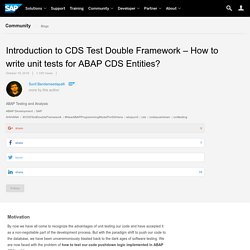
But with the paradigm shift to push our code to the database, we have been unceremoniously blasted back to the dark ages of software testing. We are now faced with the problem of how to test our code pushdown logic implemented in ABAP CDS entities. CDS Test Double Framework enables developers to test the logic expressed in their CDS entities in an automated way using the well-known ABAP Unit Test Framework. Challenges. Simplify & structure your Enhancements by using Switchable Kernel BAdIs. Quite often we come across such cumbersome enhancement implementations at various customer sites that are not only difficult to support but has very little or no reusability at all across the development landscape.
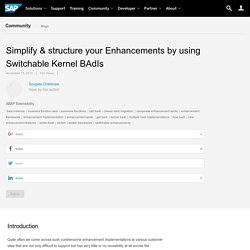
The source code behind these enhancements continue to grow from bad to worse over time as the business continues to request changes to these objects frequently as the business itself grows and evolves; to a point where it becomes simply a nightmare to support these objects not only from the development perspective but also from the testing standpoint, for example, to perform regression testing of all the existing functionalities when a current enhancement is extended and it results in change of behaviour of the enhancement in regards to the current business processes.
Let us take an example of a classical User Exit (UE) component in the HR module PBAS0001 and its most common implementation at customer sites. Useful tips regarding ABAP code inspector that you may not know - SAP Blogs. ABAP code inspector ( tcode SCI ) is not just a tool to ensure the correctness of your code.
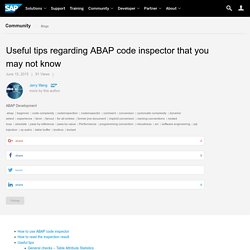
It is a powerful toolset for an ABAPer to make his life easier. This document is written based on Netweaver 7.40, unveiling some simple but useful tips about code inspector. You could find the basic steps how to leverage code inspector from this blog: A Small tip to get all transparent tables used in ABAP code There are three columns Error, Warnings and Information. The result with error would probably need your high attention as most of the time it means the bad design or wrong usage about the features checked by inspection variant. 1. 2. By clicking the arrow button, you will navigate to variant customizing window. The following parts are organized based on the original hierarchy in code inspection variant maintenance view, as displayed in the picture below: General checks – Table Attribute Statistics Performance Check Select-Statement can be transformed. See one example below. Nested Loops. Next Generation ABAP Runtime Analysis (SAT) ... SAT is the transaction name of the new ABAP Runtime Analysis Tool, which is one of the most significant improvements in ABAP in the NetWeaver 7.0 EhP2.

For those of you who are already familiar with the transaction SE30, the former ABAP Runtime Analysis Tool, transaction SAT is the successor of SE30. In SAT, ABAP's Runtime Analysis has been reworked by SAP's R&D department and has been enhanced with effective new analysis tools and features. SAT offers benefits such as a modern state-of-the art UI, new analysis tools, easy navigation between tools and so on. This third blog of the series about SAT devotes itself to the analysis of memory consumption problems and demonstrates how the new tools of SAT help you to perform an effective memory consumption analysis of any ABAP application. These series of blogs about SAT are suitable both for newbies and for experienced SE30 users. Next Generation ABAP Runtime Analysis (SAT) – Introduction SAT - Next Generation ABAP Runtime Analysis (Flash) 1.
ABAP Help Blog - Great Insight with Tips & Tricks for ABAP. How to use messages properly in the code. Commo... Dear all, Today I'm going to discuss message handling with you.
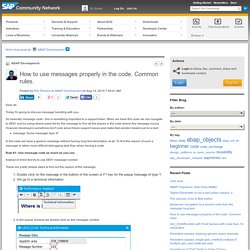
So basically message code - this is something important to a support team. When we have this code we can navigate to SE91 and by using where-used-list for the message to find all the places in the code where this message occurs. However developers sometimes don't care about future support issues and make fast solution based just on a text: message 'Some message' type 'S' In this case we have a generic message without having long text description at all. Rule #1: Use message code as much as you can. Instead of direct text try to use SE91 message number.